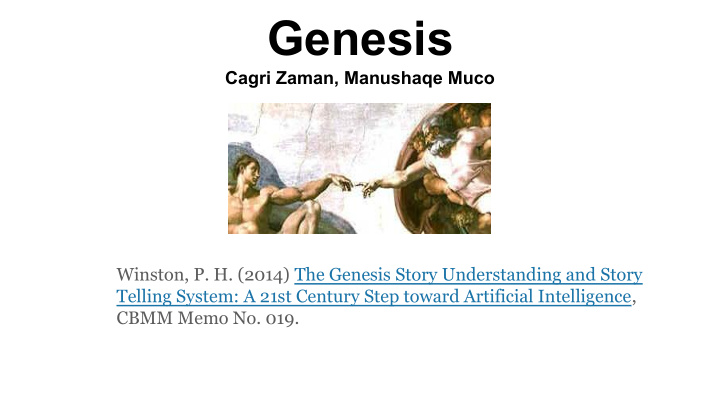



Genesis Cagri Zaman, Manushaqe Muco Winston, P. H. (2014) The Genesis Story Understanding and Story Telling System: A 21st Century Step toward Artificial Intelligence, CBMM Memo No. 019.
OUTLINE Vision: What makes humans different? Steps: Aspects of story understanding and directed perception News: The Genesis System Contributions: A 21st century step towards AI
VISION If we are to develop systems of human level intelligence, we must develop computational models of story understanding and directed perception.
VISION Tattersall, I., 2008, An Evolutionary Framework for the Acquisition of Symbolic Cognition by Homo sapiens, Comparative Cognition and Cognitive Reviews , Volume 3, pp.99-114
VISION The Inner Language Hypothesis “Using a symbolic inner language, we construct symbolic descriptions of situations and events that are far beyond the reach of other primates.”
VISION The Strong Story Hypothesis “Our inner language enables us to tell, understand, and recombine stories, and those abilities distinguish our intelligence from that of other primates.”
VISION The Directed Perception Hypothesis “Our inner language enables us to direct the resources of our perceptual systems to answer common-sense questions about real and imagined events, generating common-sense knowledge as a by-product.”
VISION The Social Animal Hypothesis Our social nature amplifies the value of story understanding and directed perception.
STEPS 1. Identify the Competence to be Understood Who ends up dead? Why did Macduff kill Macbeth? Do the stories involve revenge? Which story presents a Pyrrhic victory?
STEPS 2. Formulate Computational Problems How do we represent physical, social, and emotional relations and qualities; how do we represent actions and events; how do we represent common-sense and reflective knowledge?
STEPS 3.Propose Computational Solutions Genesis’ inner language: Categories: Class, transition, trajectory, path, place,.. Representations: Cause, goal, persuasion, belief, social relations.. Elaboration Graph Concept Patterns
STEPS 4.Develop an Exploratory Implementation Start Parser: Generate Genesis’ inner language Wordnet: classification categories
STEPS 5.Crystalize Emergent Principles Genesis exhibits some characteristics of human story understanding evidenced by its ability to answer a variety of questions about the stories it reads, yet it does its work using only about two dozen common-sense rules and another dozen reflective patterns, several of which, revenge in particular, arose frequently in our experiments.
News: Genesis System Central Idea: To understand the nature of intelligence, it is essential to shed light on how humans understand stories. Genesis analyzes stories ranging from Shakespeare’s plots to descriptions of conflicts in cyberspace. Genesis works with short story summaries , provided in English, together with low-level common-sense rules and higher-level concept patterns , likewise expressed in English. Using only a small collection of common-sense rules and concept patterns, Genesis demonstrates several story understanding capabilities.
Example of story understanding capabilities Genesis determines that both Macbeth and the 2007 Russia-Estonia Cyberwar involve revenge , even though neither the word revenge nor any of its synonyms are mentioned.
Genesis deploys common sense rules to develop basic understanding ● Use START to translate Genesis English into inner language of relations and events. ● Use common sense to build an elaboration graph . ● Story elements: ○ Yellow: established by inference rules ○ Orange: established by story; connected by explanation rules ○ Blue: by story; connected by leads-to expressions ○ White: by story
Elaboration Graph
Genesis reflects on its reading, searching for concepts ● After elaboration graph is built, Genesis uses ordinary search to find instances of concept patterns.
Concept Patterns In Green
Genesis reads stories with controllable allegiances and cultural biases ● Genesis’s interpretation depends on the common sense rules, concept patterns supplied, and biases of the reader. ● Examples: ○ Estonia-Russia cyberwar: reader friendly to Estonia VS reader friendly to Russia ○ Macbeth: western reader VS eastern reader
Estonia-Russia cyberwar: Estonia friendly VS Russian friendly
Genesis models personality traits Genesis infers personality traits on the basis of people’s action. It also uses personality traits to explain acts. ● Example: In Macbeth - vicious
Genesis answers basic questions about why and when ● Genesis answers questions on various levels. ● Example of levels: ○ Using elements of elaborations graphs ○ Using personality traits
Genesis notes concept onsets, anticipating trouble This involves leads-to relations.
Genesis calculates similarity using concepts Genesis judges similarity in multiple ways: ● Using word vectors ● Using concept vectors: seeing similarities not evident in the words.
Genesis models question-driven interpretations ● After reading a story, a question may stimulate further analysis and expose new conclusions. ● Example: ○ Eastern-Western story understanding experiment
Basic Interpretation Stimulated by a question
More capabilities ● Genesis aligns similar stories for analogical reasoning (Needleman-Wunch algorithm) ● Genesis tells and persuades using a reader model ● Genesis develops summaries
Genesis operates on all of Minsky’s six levels Correspondences between Minsky’s levels and Genesis competences: ● Inference rules: instinctive and learned reactions ● Explanation rules: deliberative thinking ● Concept patterns: reflective thinking ● Mental models: some self-reflective thinking and self-conscious reflection.
Minsky’s Six Levels
Next steps/Future ● Work under way ● Major blockers ● CBMM challenge
Work underway ● A system that composes original stories from precedents ● A system that mines literature for actions associated with personality traits ● A system that tells stories with metaphorical reference to precedents ● A system that uses story understanding apparatus to plan
Major blockers ● Getting Genesis to think about itself ● Scaling up by expanding English understanding ● The visual story
CBMM Challenge ● Understand pictures and videos computationally, developmentally, neurobiologically, and socially. ● Pictures and videos tell stories.
Contributions ● For CBMM: Handling stories told in pictures and video. ● For science in general: A better understanding of the key differentiator of our intelligence. ● For applications: The progress on the science side will constitute steps toward applications on higher level than we can hope for with today’s technology.
Recommend
More recommend